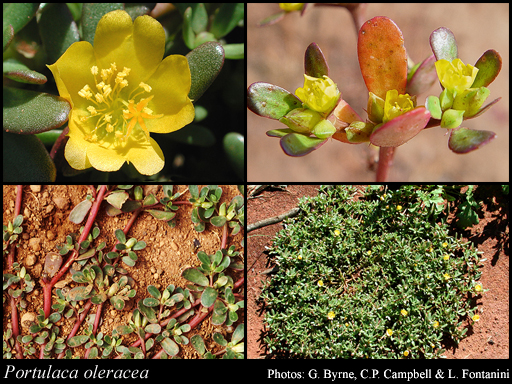- Reference
- Sp.Pl. [Linnaeus] 1:445 (1753)
- Conservation Code
- Not threatened
- Naturalised Status
- Mixed (Native in Part of Range, Naturalised Elsewhere)
- Name Status
- Current
Succulent, prostrate to decumbent annual, herb, to 0.2 m high. Fl. yellow, Apr to May. Clay loam, sand. Often disturbed sites.







Distribution
- IBRA Regions
- Avon Wheatbelt, Carnarvon, Central Kimberley, Central Ranges, Coolgardie, Dampierland, Esperance Plains, Gascoyne, Geraldton Sandplains, Gibson Desert, Great Sandy Desert, Great Victoria Desert, Jarrah Forest, Little Sandy Desert, Mallee, Murchison, Northern Kimberley, Ord Victoria Plain, Pilbara, Swan Coastal Plain, Tanami, Victoria Bonaparte, Yalgoo.
- IBRA Subregions
- Ashburton, Augustus, Cape Range, Carnegie, Central, Chichester, Eastern Goldfield, Eastern Murchison, Fitzgerald, Fitzroy Trough, Fortescue, Geraldton Hills, Hamersley, Keep, Lateritic Plain, Mackay, Mann-Musgrave Block, McLarty, Merredin, Mitchell, Mount Eliza, Northern Jarrah Forest, Pentecost, Perth, Pindanland, Purnululu, Roebourne, Rudall, Southern Jarrah Forest, Tallering, Tanami Desert, Trainor, Western Mallee, Western Murchison, Wooramel.
- IMCRA Regions
- Canning, Central West Coast, Kimberley, North West Shelf, Pilbara (nearshore), Pilbara (offshore), Shark Bay.
- Local Government Areas (LGAs)
- Ashburton, Broome, Carnarvon, Coolgardie, Cue, Derby-West Kimberley, East Pilbara, Exmouth, Gingin, Gosnells, Greater Geraldton, Halls Creek, Harvey, Karratha, Leonora, Meekatharra, Menzies, Murchison, Narembeen, Ngaanyatjarraku, Northampton, Nungarin, Port Hedland, Ravensthorpe, Sandstone, Shark Bay, Upper Gascoyne, West Arthur, Wiluna, Wyndham-East Kimberley, Yalgoo.
Management Notes (for the Swan NRM Region)
Alternative Names. Common Purslane, Purslane.
General Biology. Growth form. Herb. Life form. Annual. Reproduction. Seed, occasionally stem fragments. Dispersal. Wind, water soil, birds. Toxicity. Can be poisonous to mammals. Seedbank persistence. 40 years.
Notes. A variable plant across Australia that may include native and introduced forms. Widely naturalised. Thrives in temperate and tropical regions. Most seed germinates in autumn. Dense colonies can appear after rain, particularly in inland areas. Moderately tolerant of salinity. Will shoot from stem fragments under moist conditions.
Additional information. History of use/introduction. Human food, forage, medicines.
Suggested method of management and control. Hand remove before flowering. Otherwise spot spray 0.5% glyphosate. Read the manufacturers' labels and material safety data sheets before using herbicides. For further information consult the Australian Pesticides and Veterinary Medicines Authority to determine the status of permits for your situation or state.
Management Calendar
| Calendar Type | Jan | Feb | Mar | Apr | May | Jun | Jul | Aug | Sep | Oct | Nov | Dec | Comments |
|---|---|---|---|---|---|---|---|---|---|---|---|---|---|
| Germination | Y | Y | |||||||||||
| Active Growth | Y | Y | O | O | Y | ||||||||
| Flowering | Y | Y | Y | Y | |||||||||
| Fruiting | Y | Y | |||||||||||
| Manual Removal | Y | Y | |||||||||||
| Herbicide Treatment | Y | Y | Y |
Legend: Y = Yes, regularly, O = Occasionally, U = Uncertain, referred by others but not confirmed.
References
- Brown, K. & Brooks, K. (2002) Bushland Weeds: A Practical Guide to their Management. Environmental Weeds Action Network, Greenwood.
- Hussey, B.M.J., Keighery, G.J., Dodd, J., Lloyd, S.G. & Cousens, R.D. (2007) Western Weeds. A guide to the weeds of Western Australia. 2nd Edition. The Plant Protection Society of Western Australia, Victoria Park.
- Mitich, L.W. (1997) Common purslane (Portulaca oleracea). Weed Technology, 11 (2): 394-397.
- Moore, C.B. & Moore, J.H. (2002) Herbiguide, the pesticide expert on a disk. Herbiguide, PO Box 44 Albany, Western Australia, 6330.
- USDA, ARS, National Genetic Resources Program (2009) Germplasm Resources Information Network - (GRIN). National Germplasm Resources Laboratory, Beltsville, Maryland. URL: https://npgsweb.ars-grin.gov/gringlobal/taxon/taxonomysimple.aspx - Accessed October 2009.